Business Administration Report: Office Management and Practices
VerifiedAdded on 2020/06/04
|19
|5719
|281
Report
AI Summary
This report provides a comprehensive overview of office management procedures and business communication strategies. It delves into the requirements for establishing and implementing effective office management, including managing work effectiveness, handling office facilities and budgets, and designing efficient office systems. The report also addresses mail handling procedures, including dealing with junk mail, handling problems with incoming and outgoing mail, operating franking machines, and reporting suspicious items. Additionally, it explores employee rights and responsibilities, career pathways, and sources of industry information. The report also covers producing business documents, including language, tone, and presentation requirements, as well as integrating images and adhering to data protection and copyright laws. Furthermore, it discusses producing meeting minutes, presentation software, and promoting equality, diversity, and inclusion in the workplace. The report concludes with a detailed analysis of the interrelation of marketing and business communication.
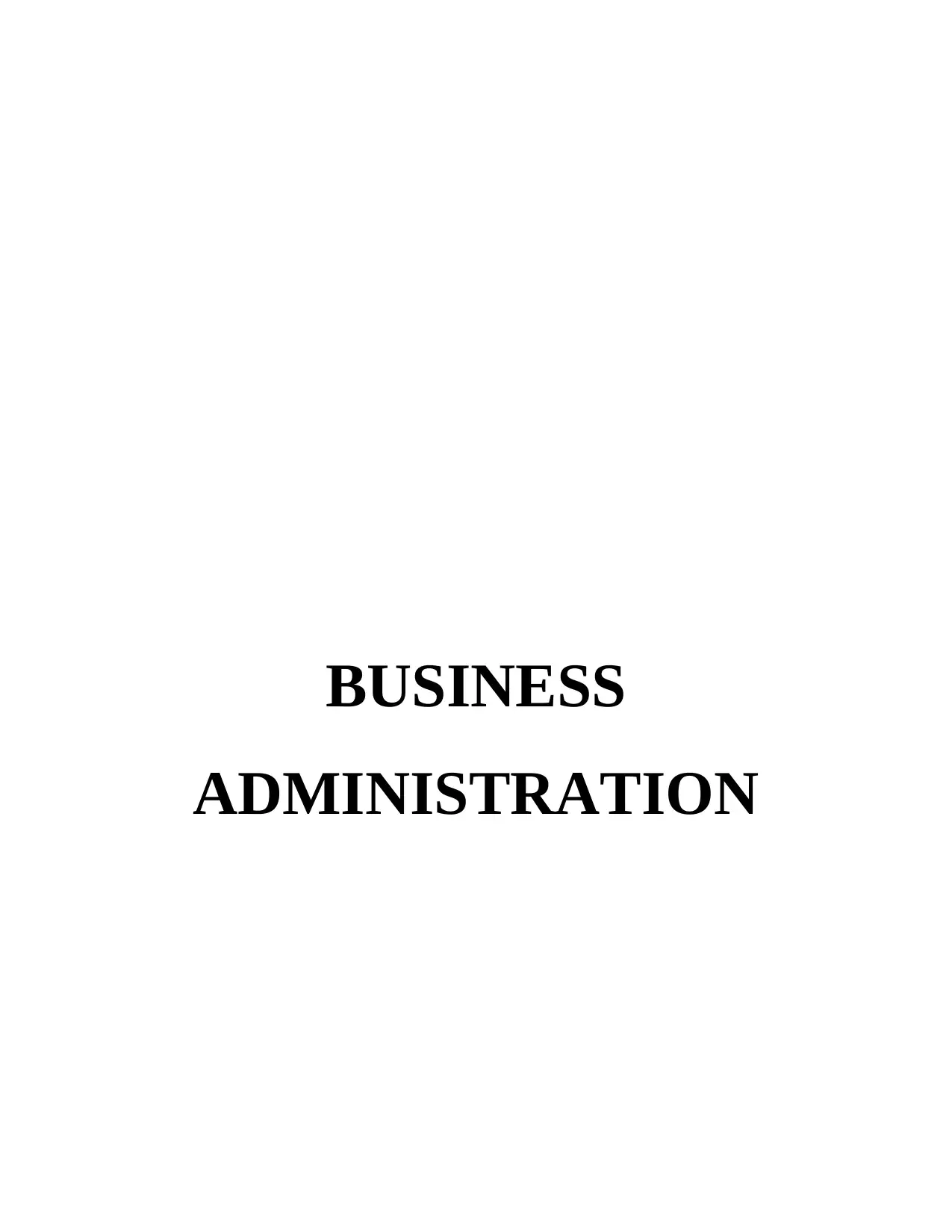
BUSINESS
ADMINISTRATION
ADMINISTRATION
Paraphrase This Document
Need a fresh take? Get an instant paraphrase of this document with our AI Paraphraser
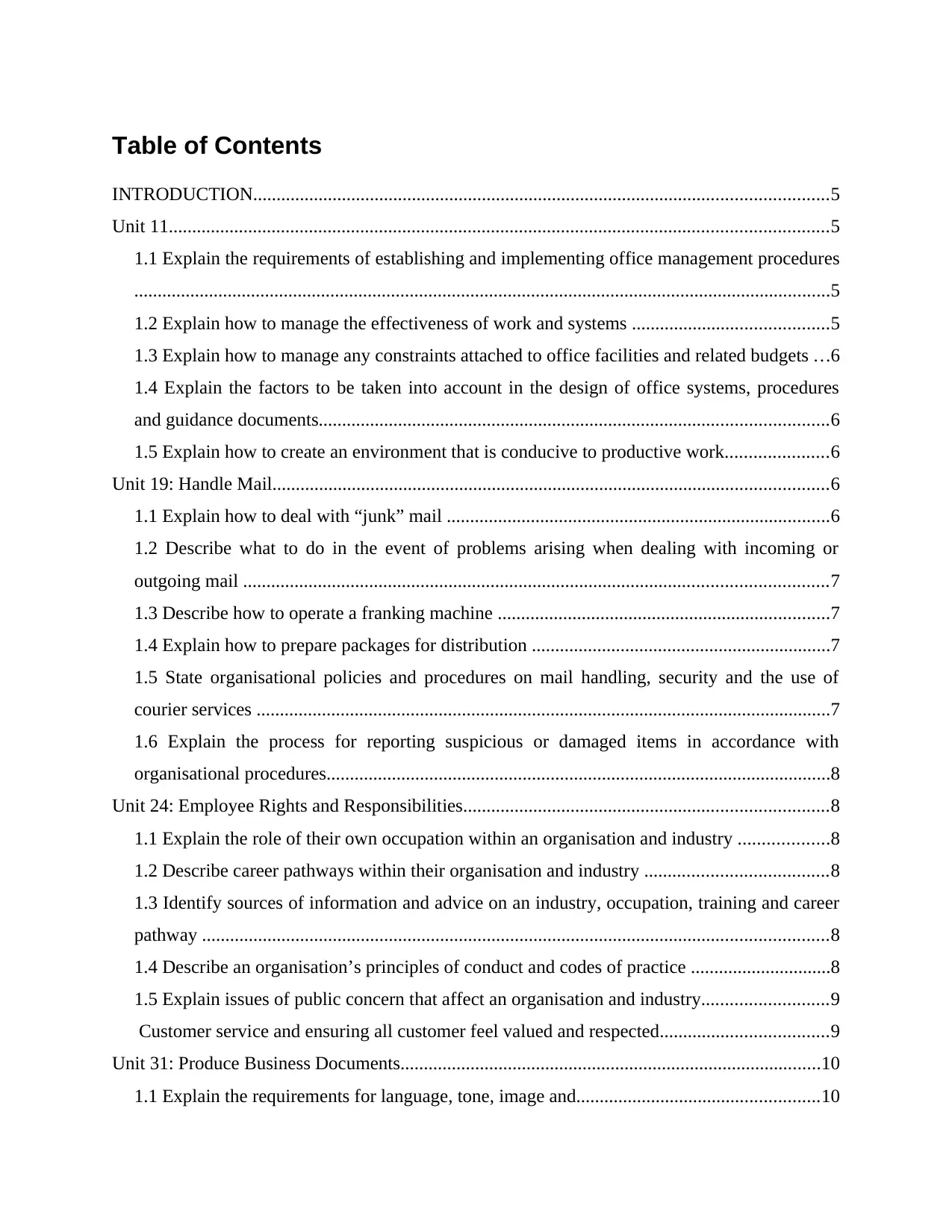
Table of Contents
INTRODUCTION...........................................................................................................................5
Unit 11.............................................................................................................................................5
1.1 Explain the requirements of establishing and implementing office management procedures
.....................................................................................................................................................5
1.2 Explain how to manage the effectiveness of work and systems ..........................................5
1.3 Explain how to manage any constraints attached to office facilities and related budgets ...6
1.4 Explain the factors to be taken into account in the design of office systems, procedures
and guidance documents.............................................................................................................6
1.5 Explain how to create an environment that is conducive to productive work......................6
Unit 19: Handle Mail.......................................................................................................................6
1.1 Explain how to deal with “junk” mail ..................................................................................6
1.2 Describe what to do in the event of problems arising when dealing with incoming or
outgoing mail .............................................................................................................................7
1.3 Describe how to operate a franking machine .......................................................................7
1.4 Explain how to prepare packages for distribution ................................................................7
1.5 State organisational policies and procedures on mail handling, security and the use of
courier services ...........................................................................................................................7
1.6 Explain the process for reporting suspicious or damaged items in accordance with
organisational procedures............................................................................................................8
Unit 24: Employee Rights and Responsibilities..............................................................................8
1.1 Explain the role of their own occupation within an organisation and industry ...................8
1.2 Describe career pathways within their organisation and industry .......................................8
1.3 Identify sources of information and advice on an industry, occupation, training and career
pathway ......................................................................................................................................8
1.4 Describe an organisation’s principles of conduct and codes of practice ..............................8
1.5 Explain issues of public concern that affect an organisation and industry...........................9
Customer service and ensuring all customer feel valued and respected....................................9
Unit 31: Produce Business Documents..........................................................................................10
1.1 Explain the requirements for language, tone, image and....................................................10
INTRODUCTION...........................................................................................................................5
Unit 11.............................................................................................................................................5
1.1 Explain the requirements of establishing and implementing office management procedures
.....................................................................................................................................................5
1.2 Explain how to manage the effectiveness of work and systems ..........................................5
1.3 Explain how to manage any constraints attached to office facilities and related budgets ...6
1.4 Explain the factors to be taken into account in the design of office systems, procedures
and guidance documents.............................................................................................................6
1.5 Explain how to create an environment that is conducive to productive work......................6
Unit 19: Handle Mail.......................................................................................................................6
1.1 Explain how to deal with “junk” mail ..................................................................................6
1.2 Describe what to do in the event of problems arising when dealing with incoming or
outgoing mail .............................................................................................................................7
1.3 Describe how to operate a franking machine .......................................................................7
1.4 Explain how to prepare packages for distribution ................................................................7
1.5 State organisational policies and procedures on mail handling, security and the use of
courier services ...........................................................................................................................7
1.6 Explain the process for reporting suspicious or damaged items in accordance with
organisational procedures............................................................................................................8
Unit 24: Employee Rights and Responsibilities..............................................................................8
1.1 Explain the role of their own occupation within an organisation and industry ...................8
1.2 Describe career pathways within their organisation and industry .......................................8
1.3 Identify sources of information and advice on an industry, occupation, training and career
pathway ......................................................................................................................................8
1.4 Describe an organisation’s principles of conduct and codes of practice ..............................8
1.5 Explain issues of public concern that affect an organisation and industry...........................9
Customer service and ensuring all customer feel valued and respected....................................9
Unit 31: Produce Business Documents..........................................................................................10
1.1 Explain the requirements for language, tone, image and....................................................10
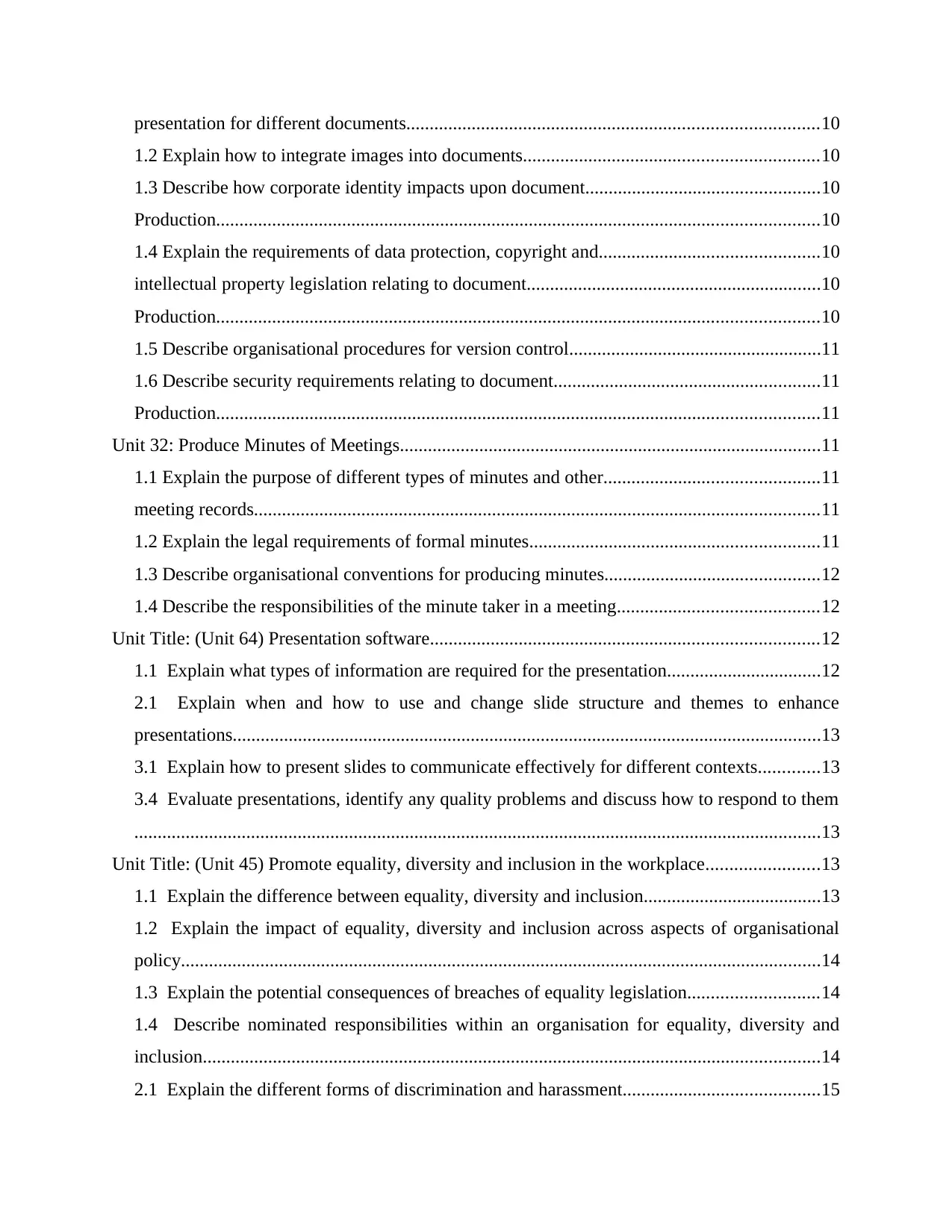
presentation for different documents........................................................................................10
1.2 Explain how to integrate images into documents...............................................................10
1.3 Describe how corporate identity impacts upon document..................................................10
Production.................................................................................................................................10
1.4 Explain the requirements of data protection, copyright and...............................................10
intellectual property legislation relating to document...............................................................10
Production.................................................................................................................................10
1.5 Describe organisational procedures for version control......................................................11
1.6 Describe security requirements relating to document.........................................................11
Production.................................................................................................................................11
Unit 32: Produce Minutes of Meetings..........................................................................................11
1.1 Explain the purpose of different types of minutes and other..............................................11
meeting records.........................................................................................................................11
1.2 Explain the legal requirements of formal minutes..............................................................11
1.3 Describe organisational conventions for producing minutes..............................................12
1.4 Describe the responsibilities of the minute taker in a meeting...........................................12
Unit Title: (Unit 64) Presentation software...................................................................................12
1.1 Explain what types of information are required for the presentation.................................12
2.1 Explain when and how to use and change slide structure and themes to enhance
presentations..............................................................................................................................13
3.1 Explain how to present slides to communicate effectively for different contexts.............13
3.4 Evaluate presentations, identify any quality problems and discuss how to respond to them
...................................................................................................................................................13
Unit Title: (Unit 45) Promote equality, diversity and inclusion in the workplace........................13
1.1 Explain the difference between equality, diversity and inclusion......................................13
1.2 Explain the impact of equality, diversity and inclusion across aspects of organisational
policy.........................................................................................................................................14
1.3 Explain the potential consequences of breaches of equality legislation............................14
1.4 Describe nominated responsibilities within an organisation for equality, diversity and
inclusion....................................................................................................................................14
2.1 Explain the different forms of discrimination and harassment..........................................15
1.2 Explain how to integrate images into documents...............................................................10
1.3 Describe how corporate identity impacts upon document..................................................10
Production.................................................................................................................................10
1.4 Explain the requirements of data protection, copyright and...............................................10
intellectual property legislation relating to document...............................................................10
Production.................................................................................................................................10
1.5 Describe organisational procedures for version control......................................................11
1.6 Describe security requirements relating to document.........................................................11
Production.................................................................................................................................11
Unit 32: Produce Minutes of Meetings..........................................................................................11
1.1 Explain the purpose of different types of minutes and other..............................................11
meeting records.........................................................................................................................11
1.2 Explain the legal requirements of formal minutes..............................................................11
1.3 Describe organisational conventions for producing minutes..............................................12
1.4 Describe the responsibilities of the minute taker in a meeting...........................................12
Unit Title: (Unit 64) Presentation software...................................................................................12
1.1 Explain what types of information are required for the presentation.................................12
2.1 Explain when and how to use and change slide structure and themes to enhance
presentations..............................................................................................................................13
3.1 Explain how to present slides to communicate effectively for different contexts.............13
3.4 Evaluate presentations, identify any quality problems and discuss how to respond to them
...................................................................................................................................................13
Unit Title: (Unit 45) Promote equality, diversity and inclusion in the workplace........................13
1.1 Explain the difference between equality, diversity and inclusion......................................13
1.2 Explain the impact of equality, diversity and inclusion across aspects of organisational
policy.........................................................................................................................................14
1.3 Explain the potential consequences of breaches of equality legislation............................14
1.4 Describe nominated responsibilities within an organisation for equality, diversity and
inclusion....................................................................................................................................14
2.1 Explain the different forms of discrimination and harassment..........................................15
⊘ This is a preview!⊘
Do you want full access?
Subscribe today to unlock all pages.

Trusted by 1+ million students worldwide
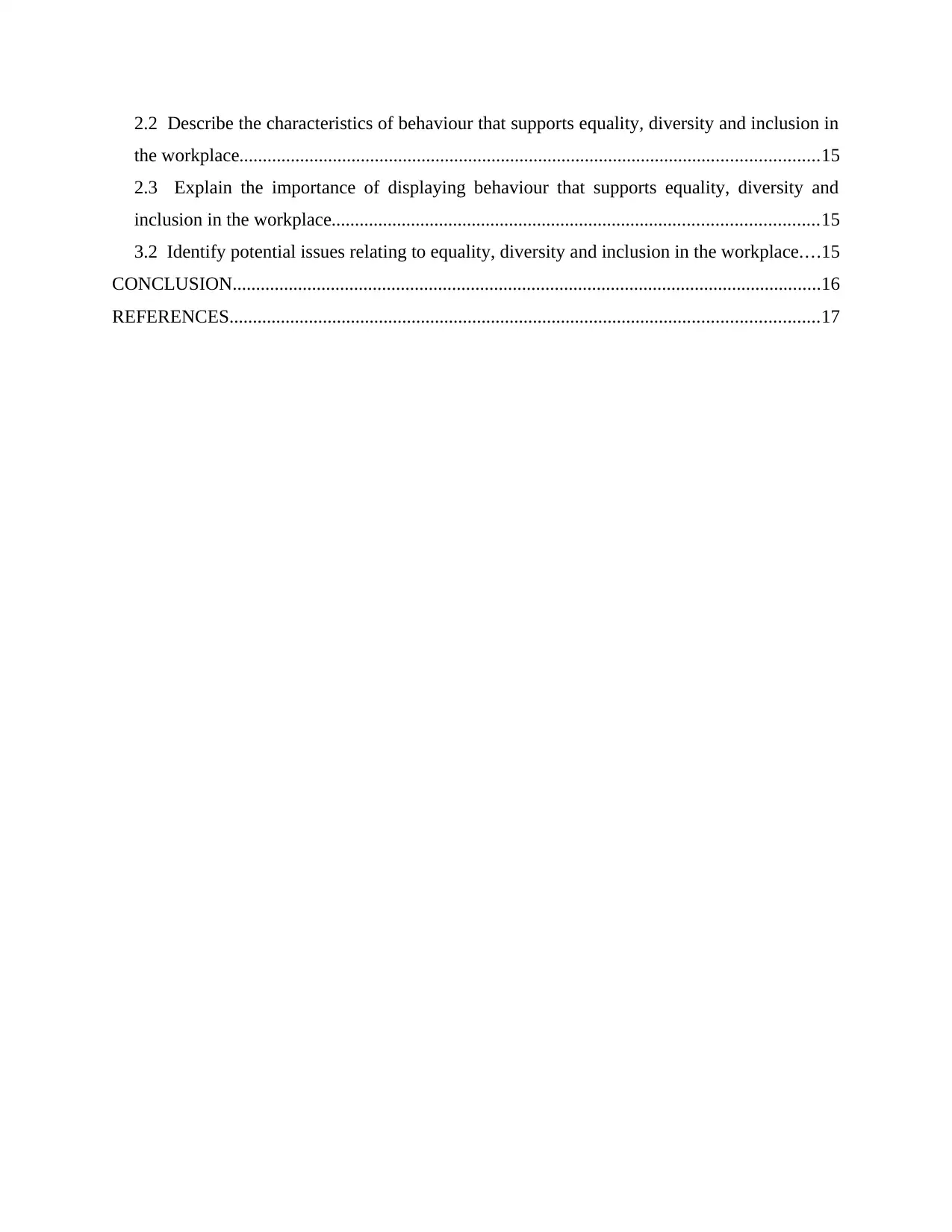
2.2 Describe the characteristics of behaviour that supports equality, diversity and inclusion in
the workplace............................................................................................................................15
2.3 Explain the importance of displaying behaviour that supports equality, diversity and
inclusion in the workplace........................................................................................................15
3.2 Identify potential issues relating to equality, diversity and inclusion in the workplace....15
CONCLUSION..............................................................................................................................16
REFERENCES..............................................................................................................................17
the workplace............................................................................................................................15
2.3 Explain the importance of displaying behaviour that supports equality, diversity and
inclusion in the workplace........................................................................................................15
3.2 Identify potential issues relating to equality, diversity and inclusion in the workplace....15
CONCLUSION..............................................................................................................................16
REFERENCES..............................................................................................................................17
Paraphrase This Document
Need a fresh take? Get an instant paraphrase of this document with our AI Paraphraser
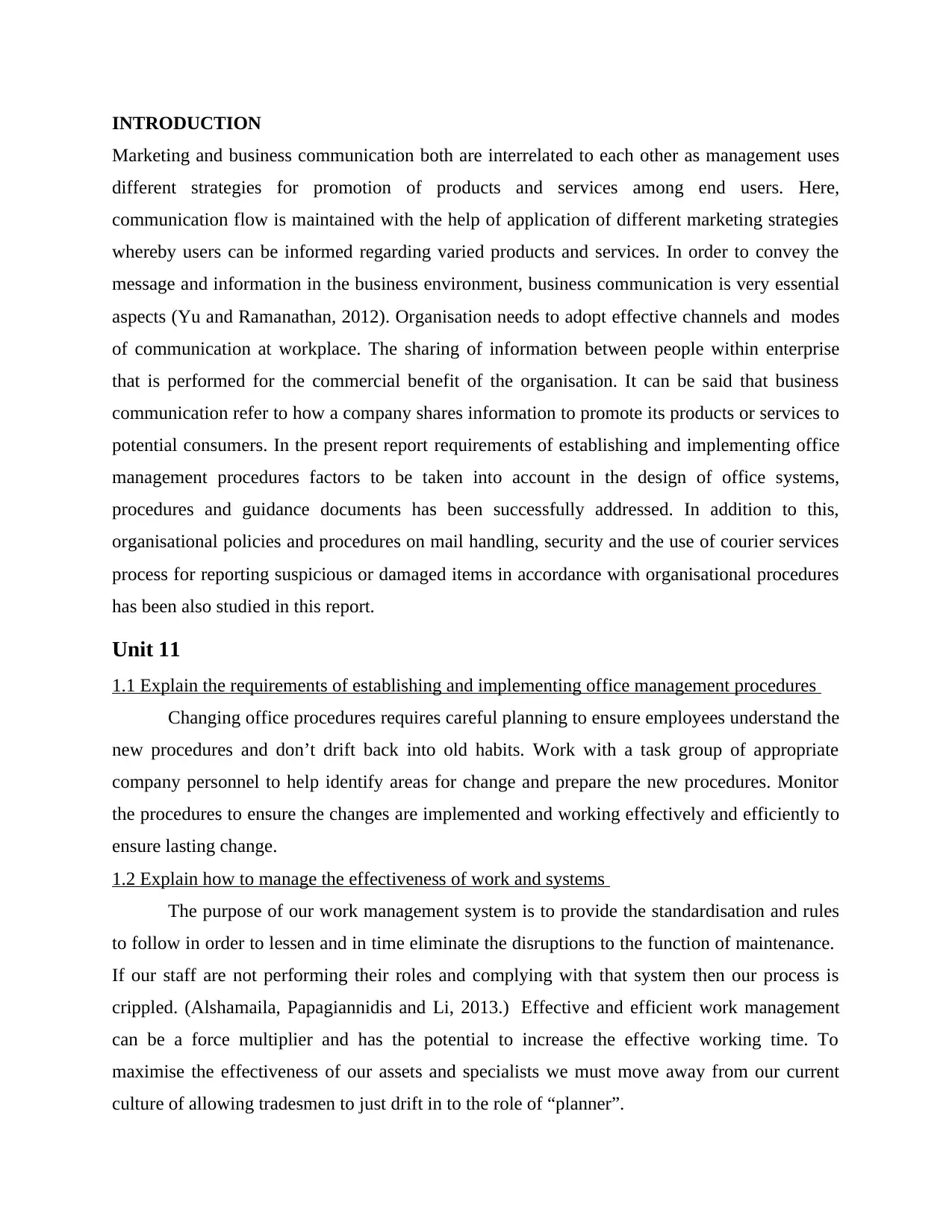
INTRODUCTION
Marketing and business communication both are interrelated to each other as management uses
different strategies for promotion of products and services among end users. Here,
communication flow is maintained with the help of application of different marketing strategies
whereby users can be informed regarding varied products and services. In order to convey the
message and information in the business environment, business communication is very essential
aspects (Yu and Ramanathan, 2012). Organisation needs to adopt effective channels and modes
of communication at workplace. The sharing of information between people within enterprise
that is performed for the commercial benefit of the organisation. It can be said that business
communication refer to how a company shares information to promote its products or services to
potential consumers. In the present report requirements of establishing and implementing office
management procedures factors to be taken into account in the design of office systems,
procedures and guidance documents has been successfully addressed. In addition to this,
organisational policies and procedures on mail handling, security and the use of courier services
process for reporting suspicious or damaged items in accordance with organisational procedures
has been also studied in this report.
Unit 11
1.1 Explain the requirements of establishing and implementing office management procedures
Changing office procedures requires careful planning to ensure employees understand the
new procedures and don’t drift back into old habits. Work with a task group of appropriate
company personnel to help identify areas for change and prepare the new procedures. Monitor
the procedures to ensure the changes are implemented and working effectively and efficiently to
ensure lasting change.
1.2 Explain how to manage the effectiveness of work and systems
The purpose of our work management system is to provide the standardisation and rules
to follow in order to lessen and in time eliminate the disruptions to the function of maintenance.
If our staff are not performing their roles and complying with that system then our process is
crippled. (Alshamaila, Papagiannidis and Li, 2013.) Effective and efficient work management
can be a force multiplier and has the potential to increase the effective working time. To
maximise the effectiveness of our assets and specialists we must move away from our current
culture of allowing tradesmen to just drift in to the role of “planner”.
Marketing and business communication both are interrelated to each other as management uses
different strategies for promotion of products and services among end users. Here,
communication flow is maintained with the help of application of different marketing strategies
whereby users can be informed regarding varied products and services. In order to convey the
message and information in the business environment, business communication is very essential
aspects (Yu and Ramanathan, 2012). Organisation needs to adopt effective channels and modes
of communication at workplace. The sharing of information between people within enterprise
that is performed for the commercial benefit of the organisation. It can be said that business
communication refer to how a company shares information to promote its products or services to
potential consumers. In the present report requirements of establishing and implementing office
management procedures factors to be taken into account in the design of office systems,
procedures and guidance documents has been successfully addressed. In addition to this,
organisational policies and procedures on mail handling, security and the use of courier services
process for reporting suspicious or damaged items in accordance with organisational procedures
has been also studied in this report.
Unit 11
1.1 Explain the requirements of establishing and implementing office management procedures
Changing office procedures requires careful planning to ensure employees understand the
new procedures and don’t drift back into old habits. Work with a task group of appropriate
company personnel to help identify areas for change and prepare the new procedures. Monitor
the procedures to ensure the changes are implemented and working effectively and efficiently to
ensure lasting change.
1.2 Explain how to manage the effectiveness of work and systems
The purpose of our work management system is to provide the standardisation and rules
to follow in order to lessen and in time eliminate the disruptions to the function of maintenance.
If our staff are not performing their roles and complying with that system then our process is
crippled. (Alshamaila, Papagiannidis and Li, 2013.) Effective and efficient work management
can be a force multiplier and has the potential to increase the effective working time. To
maximise the effectiveness of our assets and specialists we must move away from our current
culture of allowing tradesmen to just drift in to the role of “planner”.
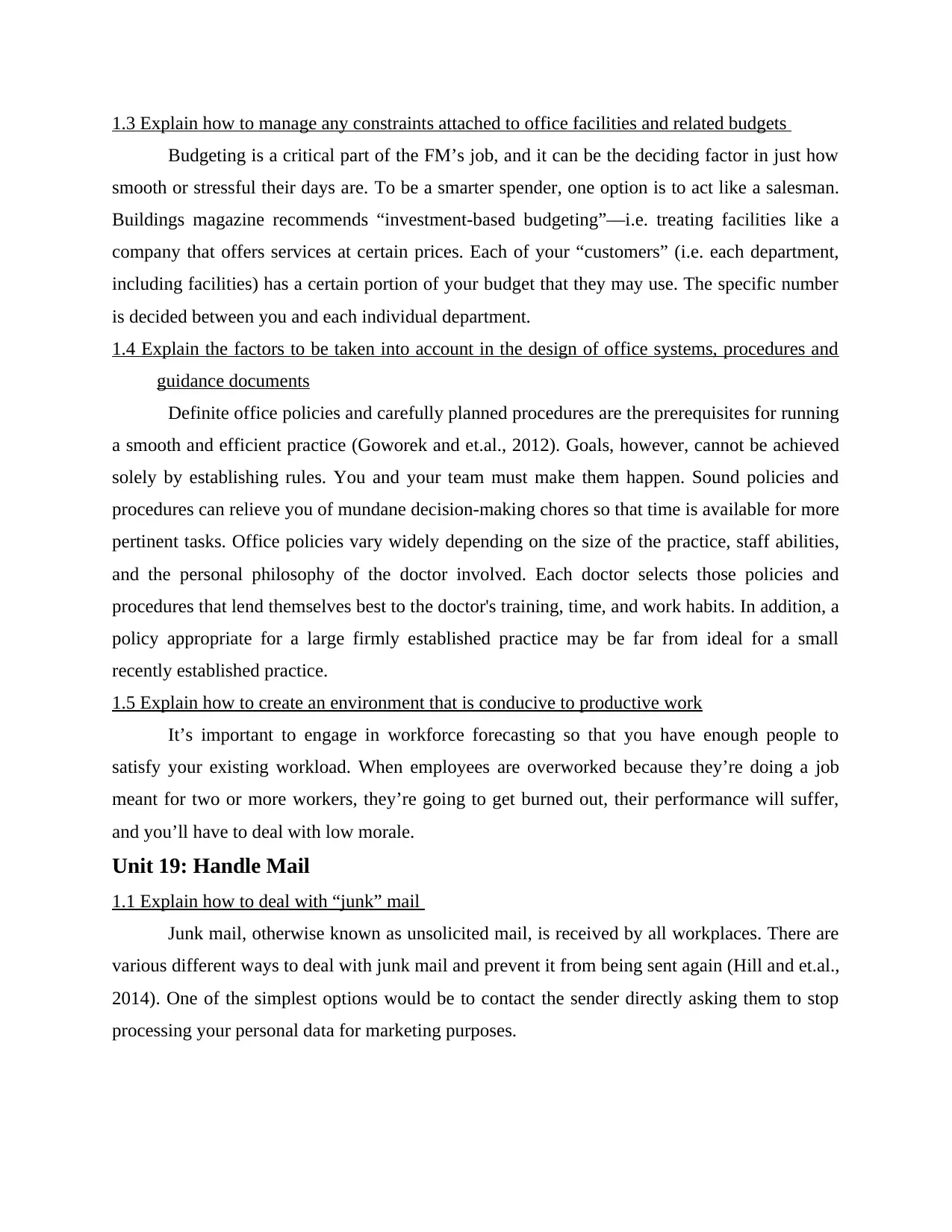
1.3 Explain how to manage any constraints attached to office facilities and related budgets
Budgeting is a critical part of the FM’s job, and it can be the deciding factor in just how
smooth or stressful their days are. To be a smarter spender, one option is to act like a salesman.
Buildings magazine recommends “investment-based budgeting”—i.e. treating facilities like a
company that offers services at certain prices. Each of your “customers” (i.e. each department,
including facilities) has a certain portion of your budget that they may use. The specific number
is decided between you and each individual department.
1.4 Explain the factors to be taken into account in the design of office systems, procedures and
guidance documents
Definite office policies and carefully planned procedures are the prerequisites for running
a smooth and efficient practice (Goworek and et.al., 2012). Goals, however, cannot be achieved
solely by establishing rules. You and your team must make them happen. Sound policies and
procedures can relieve you of mundane decision-making chores so that time is available for more
pertinent tasks. Office policies vary widely depending on the size of the practice, staff abilities,
and the personal philosophy of the doctor involved. Each doctor selects those policies and
procedures that lend themselves best to the doctor's training, time, and work habits. In addition, a
policy appropriate for a large firmly established practice may be far from ideal for a small
recently established practice.
1.5 Explain how to create an environment that is conducive to productive work
It’s important to engage in workforce forecasting so that you have enough people to
satisfy your existing workload. When employees are overworked because they’re doing a job
meant for two or more workers, they’re going to get burned out, their performance will suffer,
and you’ll have to deal with low morale.
Unit 19: Handle Mail
1.1 Explain how to deal with “junk” mail
Junk mail, otherwise known as unsolicited mail, is received by all workplaces. There are
various different ways to deal with junk mail and prevent it from being sent again (Hill and et.al.,
2014). One of the simplest options would be to contact the sender directly asking them to stop
processing your personal data for marketing purposes.
Budgeting is a critical part of the FM’s job, and it can be the deciding factor in just how
smooth or stressful their days are. To be a smarter spender, one option is to act like a salesman.
Buildings magazine recommends “investment-based budgeting”—i.e. treating facilities like a
company that offers services at certain prices. Each of your “customers” (i.e. each department,
including facilities) has a certain portion of your budget that they may use. The specific number
is decided between you and each individual department.
1.4 Explain the factors to be taken into account in the design of office systems, procedures and
guidance documents
Definite office policies and carefully planned procedures are the prerequisites for running
a smooth and efficient practice (Goworek and et.al., 2012). Goals, however, cannot be achieved
solely by establishing rules. You and your team must make them happen. Sound policies and
procedures can relieve you of mundane decision-making chores so that time is available for more
pertinent tasks. Office policies vary widely depending on the size of the practice, staff abilities,
and the personal philosophy of the doctor involved. Each doctor selects those policies and
procedures that lend themselves best to the doctor's training, time, and work habits. In addition, a
policy appropriate for a large firmly established practice may be far from ideal for a small
recently established practice.
1.5 Explain how to create an environment that is conducive to productive work
It’s important to engage in workforce forecasting so that you have enough people to
satisfy your existing workload. When employees are overworked because they’re doing a job
meant for two or more workers, they’re going to get burned out, their performance will suffer,
and you’ll have to deal with low morale.
Unit 19: Handle Mail
1.1 Explain how to deal with “junk” mail
Junk mail, otherwise known as unsolicited mail, is received by all workplaces. There are
various different ways to deal with junk mail and prevent it from being sent again (Hill and et.al.,
2014). One of the simplest options would be to contact the sender directly asking them to stop
processing your personal data for marketing purposes.
⊘ This is a preview!⊘
Do you want full access?
Subscribe today to unlock all pages.

Trusted by 1+ million students worldwide
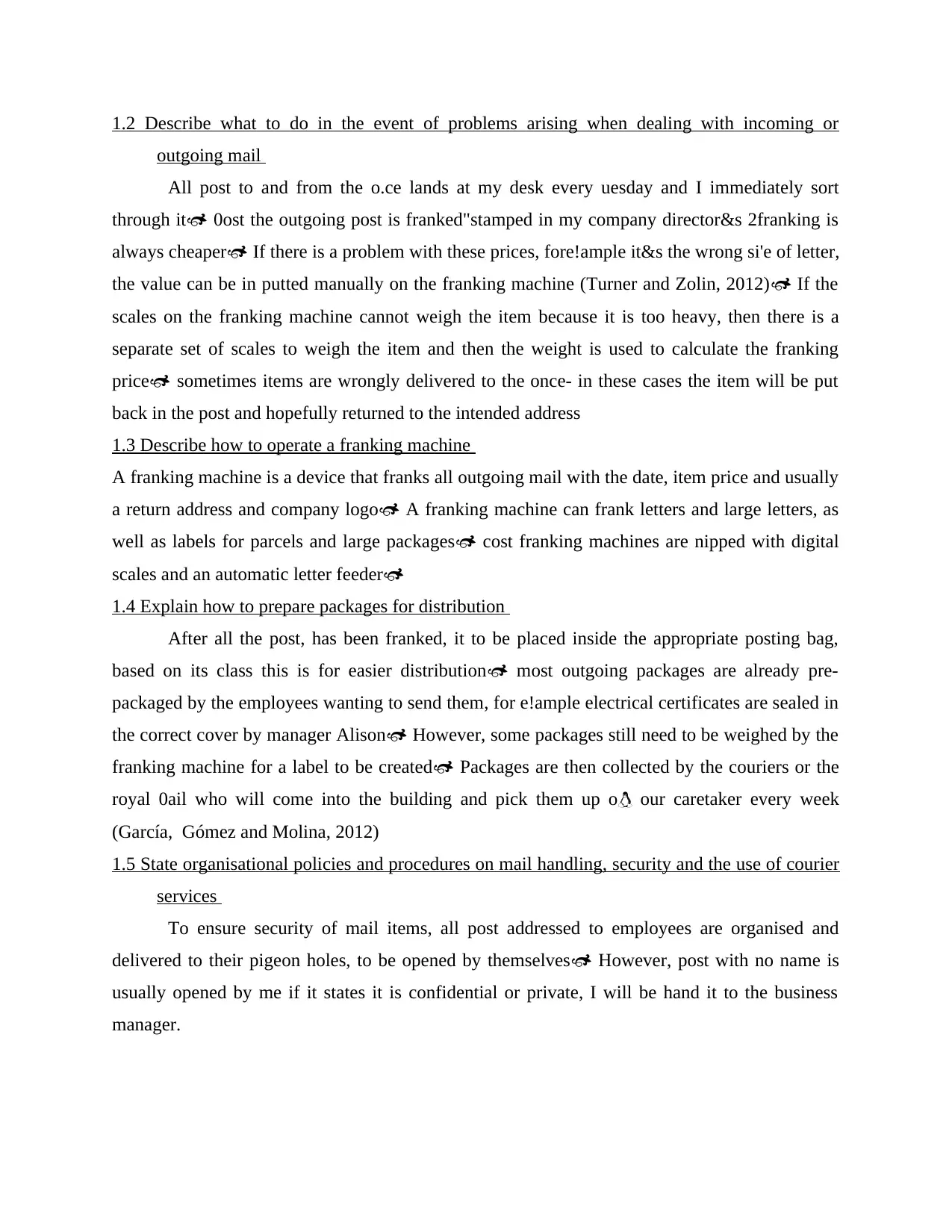
1.2 Describe what to do in the event of problems arising when dealing with incoming or
outgoing mail
All post to and from the o.ce lands at my desk every uesday and I immediately sort
through it 0ost the outgoing post is franked"stamped in my company director&s 2franking is
always cheaper If there is a problem with these prices, fore!ample it&s the wrong si'e of letter,
the value can be in putted manually on the franking machine (Turner and Zolin, 2012) If the
scales on the franking machine cannot weigh the item because it is too heavy, then there is a
separate set of scales to weigh the item and then the weight is used to calculate the franking
price sometimes items are wrongly delivered to the once- in these cases the item will be put
back in the post and hopefully returned to the intended address
1.3 Describe how to operate a franking machine
A franking machine is a device that franks all outgoing mail with the date, item price and usually
a return address and company logo A franking machine can frank letters and large letters, as
well as labels for parcels and large packages cost franking machines are nipped with digital
scales and an automatic letter feeder
1.4 Explain how to prepare packages for distribution
After all the post, has been franked, it to be placed inside the appropriate posting bag,
based on its class this is for easier distribution most outgoing packages are already pre-
packaged by the employees wanting to send them, for e!ample electrical certificates are sealed in
the correct cover by manager Alison However, some packages still need to be weighed by the
franking machine for a label to be created Packages are then collected by the couriers or the
royal 0ail who will come into the building and pick them up o our caretaker every week
(García, Gómez and Molina, 2012)
1.5 State organisational policies and procedures on mail handling, security and the use of courier
services
To ensure security of mail items, all post addressed to employees are organised and
delivered to their pigeon holes, to be opened by themselves However, post with no name is
usually opened by me if it states it is confidential or private, I will be hand it to the business
manager.
outgoing mail
All post to and from the o.ce lands at my desk every uesday and I immediately sort
through it 0ost the outgoing post is franked"stamped in my company director&s 2franking is
always cheaper If there is a problem with these prices, fore!ample it&s the wrong si'e of letter,
the value can be in putted manually on the franking machine (Turner and Zolin, 2012) If the
scales on the franking machine cannot weigh the item because it is too heavy, then there is a
separate set of scales to weigh the item and then the weight is used to calculate the franking
price sometimes items are wrongly delivered to the once- in these cases the item will be put
back in the post and hopefully returned to the intended address
1.3 Describe how to operate a franking machine
A franking machine is a device that franks all outgoing mail with the date, item price and usually
a return address and company logo A franking machine can frank letters and large letters, as
well as labels for parcels and large packages cost franking machines are nipped with digital
scales and an automatic letter feeder
1.4 Explain how to prepare packages for distribution
After all the post, has been franked, it to be placed inside the appropriate posting bag,
based on its class this is for easier distribution most outgoing packages are already pre-
packaged by the employees wanting to send them, for e!ample electrical certificates are sealed in
the correct cover by manager Alison However, some packages still need to be weighed by the
franking machine for a label to be created Packages are then collected by the couriers or the
royal 0ail who will come into the building and pick them up o our caretaker every week
(García, Gómez and Molina, 2012)
1.5 State organisational policies and procedures on mail handling, security and the use of courier
services
To ensure security of mail items, all post addressed to employees are organised and
delivered to their pigeon holes, to be opened by themselves However, post with no name is
usually opened by me if it states it is confidential or private, I will be hand it to the business
manager.
Paraphrase This Document
Need a fresh take? Get an instant paraphrase of this document with our AI Paraphraser
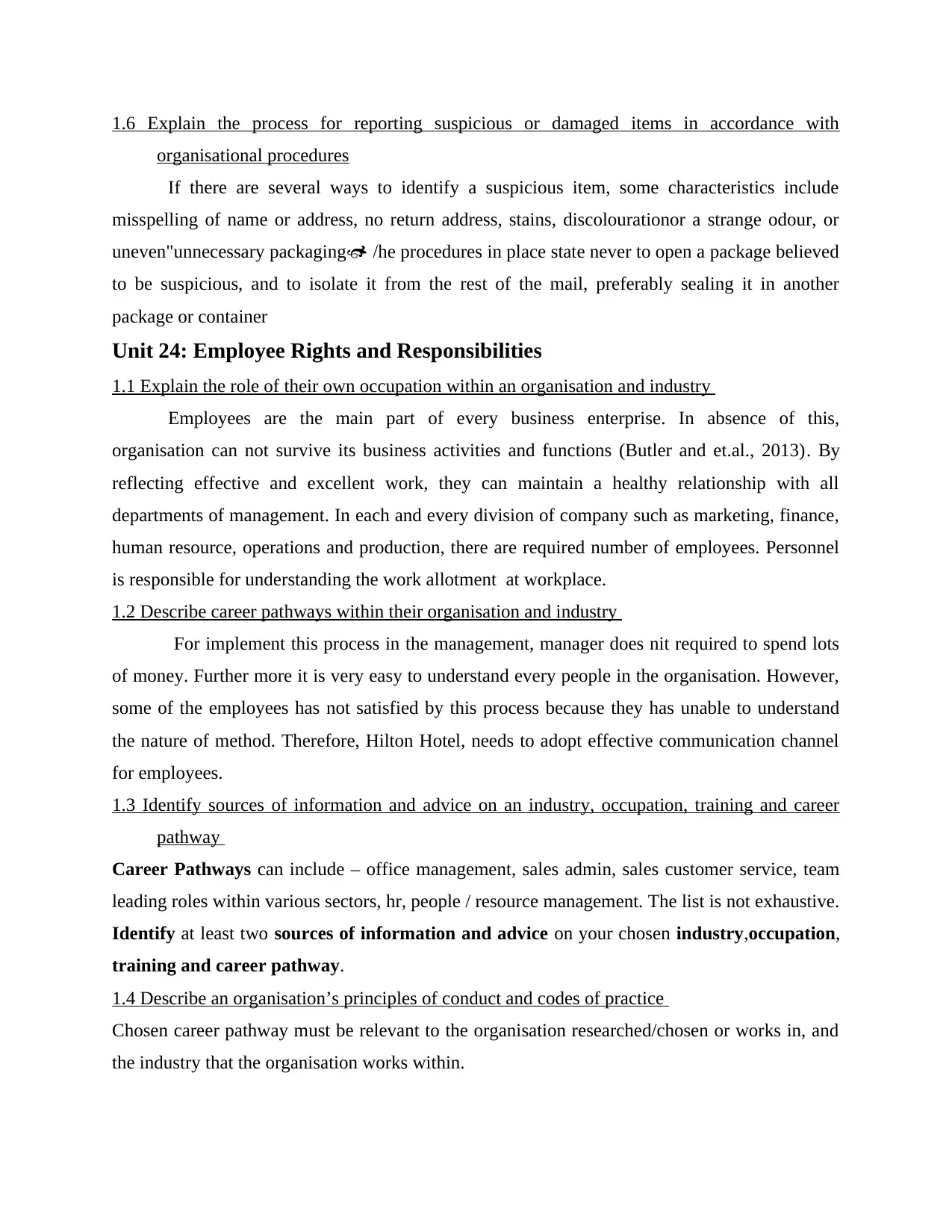
1.6 Explain the process for reporting suspicious or damaged items in accordance with
organisational procedures
If there are several ways to identify a suspicious item, some characteristics include
misspelling of name or address, no return address, stains, discolourationor a strange odour, or
uneven"unnecessary packaging /he procedures in place state never to open a package believed
to be suspicious, and to isolate it from the rest of the mail, preferably sealing it in another
package or container
Unit 24: Employee Rights and Responsibilities
1.1 Explain the role of their own occupation within an organisation and industry
Employees are the main part of every business enterprise. In absence of this,
organisation can not survive its business activities and functions (Butler and et.al., 2013). By
reflecting effective and excellent work, they can maintain a healthy relationship with all
departments of management. In each and every division of company such as marketing, finance,
human resource, operations and production, there are required number of employees. Personnel
is responsible for understanding the work allotment at workplace.
1.2 Describe career pathways within their organisation and industry
For implement this process in the management, manager does nit required to spend lots
of money. Further more it is very easy to understand every people in the organisation. However,
some of the employees has not satisfied by this process because they has unable to understand
the nature of method. Therefore, Hilton Hotel, needs to adopt effective communication channel
for employees.
1.3 Identify sources of information and advice on an industry, occupation, training and career
pathway
Career Pathways can include – office management, sales admin, sales customer service, team
leading roles within various sectors, hr, people / resource management. The list is not exhaustive.
Identify at least two sources of information and advice on your chosen industry,occupation,
training and career pathway.
1.4 Describe an organisation’s principles of conduct and codes of practice
Chosen career pathway must be relevant to the organisation researched/chosen or works in, and
the industry that the organisation works within.
organisational procedures
If there are several ways to identify a suspicious item, some characteristics include
misspelling of name or address, no return address, stains, discolourationor a strange odour, or
uneven"unnecessary packaging /he procedures in place state never to open a package believed
to be suspicious, and to isolate it from the rest of the mail, preferably sealing it in another
package or container
Unit 24: Employee Rights and Responsibilities
1.1 Explain the role of their own occupation within an organisation and industry
Employees are the main part of every business enterprise. In absence of this,
organisation can not survive its business activities and functions (Butler and et.al., 2013). By
reflecting effective and excellent work, they can maintain a healthy relationship with all
departments of management. In each and every division of company such as marketing, finance,
human resource, operations and production, there are required number of employees. Personnel
is responsible for understanding the work allotment at workplace.
1.2 Describe career pathways within their organisation and industry
For implement this process in the management, manager does nit required to spend lots
of money. Further more it is very easy to understand every people in the organisation. However,
some of the employees has not satisfied by this process because they has unable to understand
the nature of method. Therefore, Hilton Hotel, needs to adopt effective communication channel
for employees.
1.3 Identify sources of information and advice on an industry, occupation, training and career
pathway
Career Pathways can include – office management, sales admin, sales customer service, team
leading roles within various sectors, hr, people / resource management. The list is not exhaustive.
Identify at least two sources of information and advice on your chosen industry,occupation,
training and career pathway.
1.4 Describe an organisation’s principles of conduct and codes of practice
Chosen career pathway must be relevant to the organisation researched/chosen or works in, and
the industry that the organisation works within.
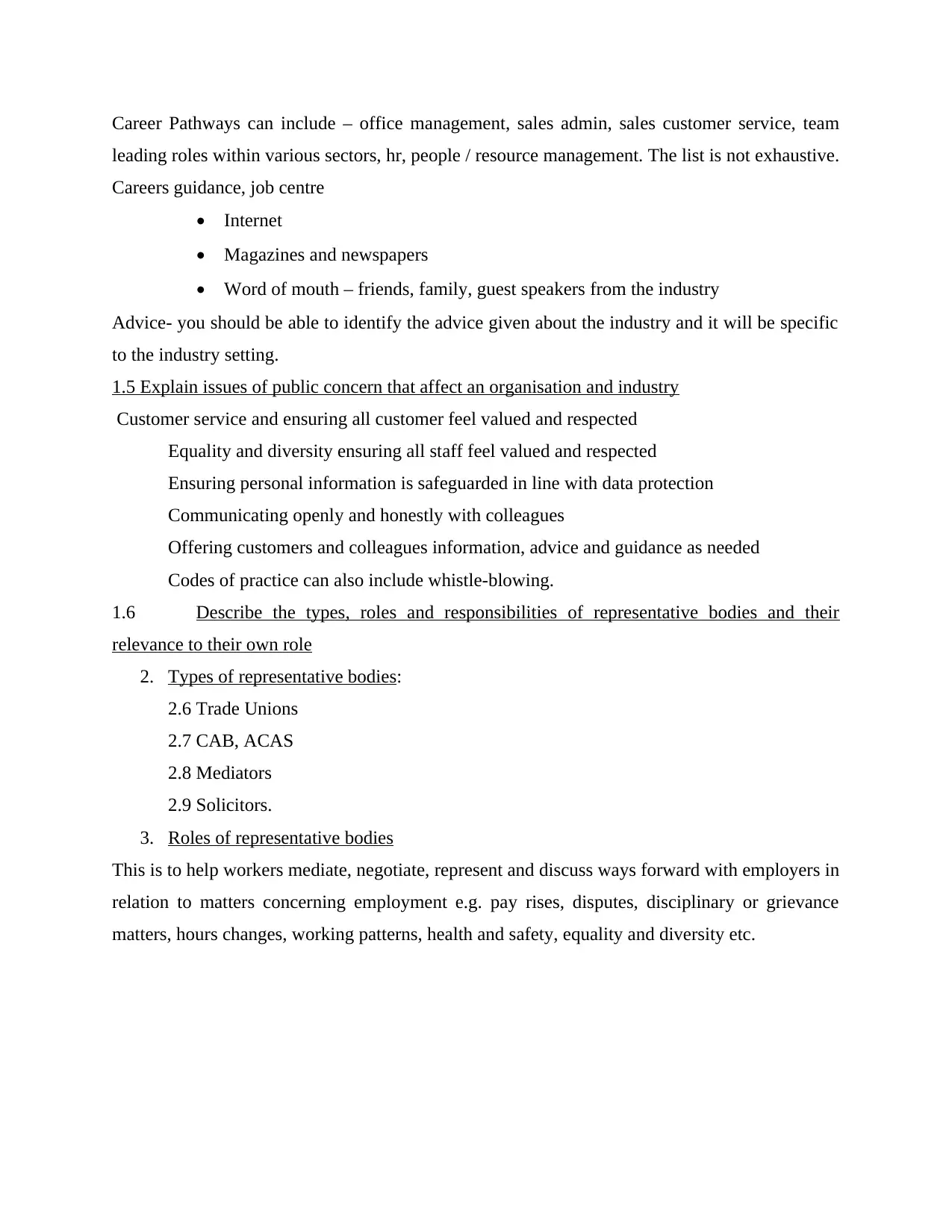
Career Pathways can include – office management, sales admin, sales customer service, team
leading roles within various sectors, hr, people / resource management. The list is not exhaustive.
Careers guidance, job centre
• Internet
• Magazines and newspapers
• Word of mouth – friends, family, guest speakers from the industry
Advice- you should be able to identify the advice given about the industry and it will be specific
to the industry setting.
1.5 Explain issues of public concern that affect an organisation and industry
Customer service and ensuring all customer feel valued and respected
Equality and diversity ensuring all staff feel valued and respected
Ensuring personal information is safeguarded in line with data protection
Communicating openly and honestly with colleagues
Offering customers and colleagues information, advice and guidance as needed
Codes of practice can also include whistle-blowing.
1.6 Describe the types, roles and responsibilities of representative bodies and their
relevance to their own role
2. Types of representative bodies:
2.6 Trade Unions
2.7 CAB, ACAS
2.8 Mediators
2.9 Solicitors.
3. Roles of representative bodies
This is to help workers mediate, negotiate, represent and discuss ways forward with employers in
relation to matters concerning employment e.g. pay rises, disputes, disciplinary or grievance
matters, hours changes, working patterns, health and safety, equality and diversity etc.
leading roles within various sectors, hr, people / resource management. The list is not exhaustive.
Careers guidance, job centre
• Internet
• Magazines and newspapers
• Word of mouth – friends, family, guest speakers from the industry
Advice- you should be able to identify the advice given about the industry and it will be specific
to the industry setting.
1.5 Explain issues of public concern that affect an organisation and industry
Customer service and ensuring all customer feel valued and respected
Equality and diversity ensuring all staff feel valued and respected
Ensuring personal information is safeguarded in line with data protection
Communicating openly and honestly with colleagues
Offering customers and colleagues information, advice and guidance as needed
Codes of practice can also include whistle-blowing.
1.6 Describe the types, roles and responsibilities of representative bodies and their
relevance to their own role
2. Types of representative bodies:
2.6 Trade Unions
2.7 CAB, ACAS
2.8 Mediators
2.9 Solicitors.
3. Roles of representative bodies
This is to help workers mediate, negotiate, represent and discuss ways forward with employers in
relation to matters concerning employment e.g. pay rises, disputes, disciplinary or grievance
matters, hours changes, working patterns, health and safety, equality and diversity etc.
⊘ This is a preview!⊘
Do you want full access?
Subscribe today to unlock all pages.

Trusted by 1+ million students worldwide
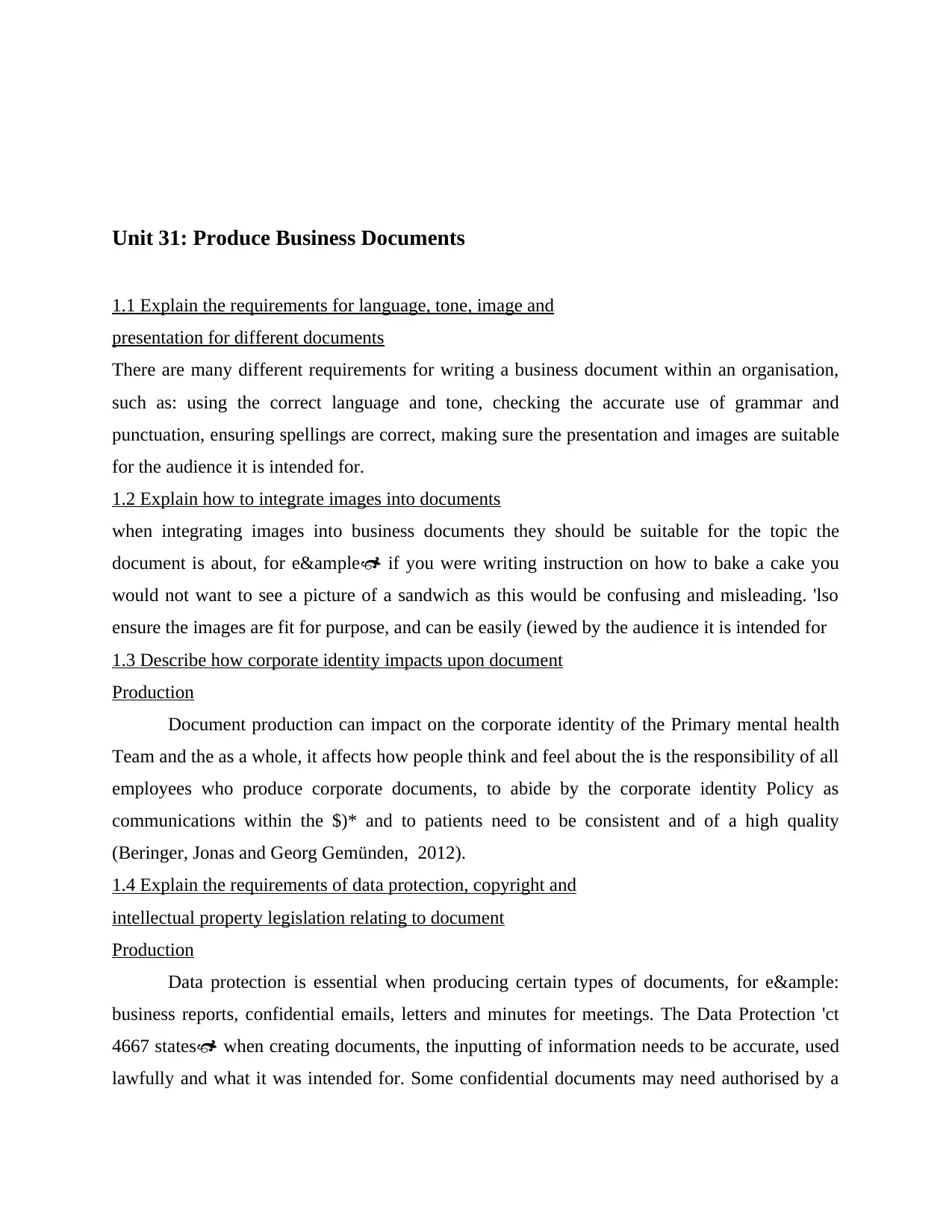
Unit 31: Produce Business Documents
1.1 Explain the requirements for language, tone, image and
presentation for different documents
There are many different requirements for writing a business document within an organisation,
such as: using the correct language and tone, checking the accurate use of grammar and
punctuation, ensuring spellings are correct, making sure the presentation and images are suitable
for the audience it is intended for.
1.2 Explain how to integrate images into documents
when integrating images into business documents they should be suitable for the topic the
document is about, for e&le if you were writing instruction on how to bake a cake you
would not want to see a picture of a sandwich as this would be confusing and misleading. 'lso
ensure the images are fit for purpose, and can be easily (iewed by the audience it is intended for
1.3 Describe how corporate identity impacts upon document
Production
Document production can impact on the corporate identity of the Primary mental health
Team and the as a whole, it affects how people think and feel about the is the responsibility of all
employees who produce corporate documents, to abide by the corporate identity Policy as
communications within the $)* and to patients need to be consistent and of a high quality
(Beringer, Jonas and Georg Gemünden, 2012).
1.4 Explain the requirements of data protection, copyright and
intellectual property legislation relating to document
Production
Data protection is essential when producing certain types of documents, for e&le:
business reports, confidential emails, letters and minutes for meetings. The Data Protection 'ct
4667 states when creating documents, the inputting of information needs to be accurate, used
lawfully and what it was intended for. Some confidential documents may need authorised by a
1.1 Explain the requirements for language, tone, image and
presentation for different documents
There are many different requirements for writing a business document within an organisation,
such as: using the correct language and tone, checking the accurate use of grammar and
punctuation, ensuring spellings are correct, making sure the presentation and images are suitable
for the audience it is intended for.
1.2 Explain how to integrate images into documents
when integrating images into business documents they should be suitable for the topic the
document is about, for e&le if you were writing instruction on how to bake a cake you
would not want to see a picture of a sandwich as this would be confusing and misleading. 'lso
ensure the images are fit for purpose, and can be easily (iewed by the audience it is intended for
1.3 Describe how corporate identity impacts upon document
Production
Document production can impact on the corporate identity of the Primary mental health
Team and the as a whole, it affects how people think and feel about the is the responsibility of all
employees who produce corporate documents, to abide by the corporate identity Policy as
communications within the $)* and to patients need to be consistent and of a high quality
(Beringer, Jonas and Georg Gemünden, 2012).
1.4 Explain the requirements of data protection, copyright and
intellectual property legislation relating to document
Production
Data protection is essential when producing certain types of documents, for e&le:
business reports, confidential emails, letters and minutes for meetings. The Data Protection 'ct
4667 states when creating documents, the inputting of information needs to be accurate, used
lawfully and what it was intended for. Some confidential documents may need authorised by a
Paraphrase This Document
Need a fresh take? Get an instant paraphrase of this document with our AI Paraphraser
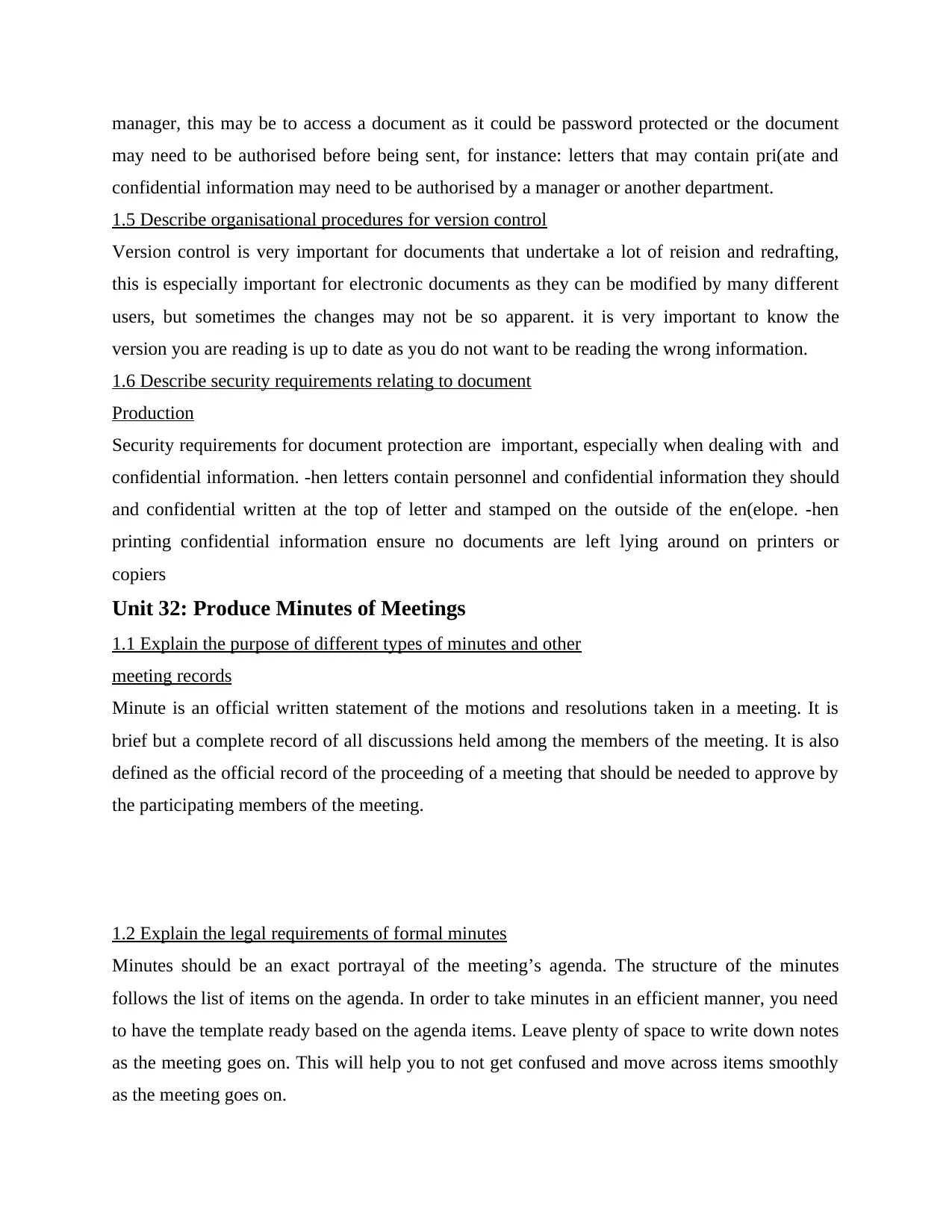
manager, this may be to access a document as it could be password protected or the document
may need to be authorised before being sent, for instance: letters that may contain pri(ate and
confidential information may need to be authorised by a manager or another department.
1.5 Describe organisational procedures for version control
Version control is very important for documents that undertake a lot of reision and redrafting,
this is especially important for electronic documents as they can be modified by many different
users, but sometimes the changes may not be so apparent. it is very important to know the
version you are reading is up to date as you do not want to be reading the wrong information.
1.6 Describe security requirements relating to document
Production
Security requirements for document protection are important, especially when dealing with and
confidential information. -hen letters contain personnel and confidential information they should
and confidential written at the top of letter and stamped on the outside of the en(elope. -hen
printing confidential information ensure no documents are left lying around on printers or
copiers
Unit 32: Produce Minutes of Meetings
1.1 Explain the purpose of different types of minutes and other
meeting records
Minute is an official written statement of the motions and resolutions taken in a meeting. It is
brief but a complete record of all discussions held among the members of the meeting. It is also
defined as the official record of the proceeding of a meeting that should be needed to approve by
the participating members of the meeting.
1.2 Explain the legal requirements of formal minutes
Minutes should be an exact portrayal of the meeting’s agenda. The structure of the minutes
follows the list of items on the agenda. In order to take minutes in an efficient manner, you need
to have the template ready based on the agenda items. Leave plenty of space to write down notes
as the meeting goes on. This will help you to not get confused and move across items smoothly
as the meeting goes on.
may need to be authorised before being sent, for instance: letters that may contain pri(ate and
confidential information may need to be authorised by a manager or another department.
1.5 Describe organisational procedures for version control
Version control is very important for documents that undertake a lot of reision and redrafting,
this is especially important for electronic documents as they can be modified by many different
users, but sometimes the changes may not be so apparent. it is very important to know the
version you are reading is up to date as you do not want to be reading the wrong information.
1.6 Describe security requirements relating to document
Production
Security requirements for document protection are important, especially when dealing with and
confidential information. -hen letters contain personnel and confidential information they should
and confidential written at the top of letter and stamped on the outside of the en(elope. -hen
printing confidential information ensure no documents are left lying around on printers or
copiers
Unit 32: Produce Minutes of Meetings
1.1 Explain the purpose of different types of minutes and other
meeting records
Minute is an official written statement of the motions and resolutions taken in a meeting. It is
brief but a complete record of all discussions held among the members of the meeting. It is also
defined as the official record of the proceeding of a meeting that should be needed to approve by
the participating members of the meeting.
1.2 Explain the legal requirements of formal minutes
Minutes should be an exact portrayal of the meeting’s agenda. The structure of the minutes
follows the list of items on the agenda. In order to take minutes in an efficient manner, you need
to have the template ready based on the agenda items. Leave plenty of space to write down notes
as the meeting goes on. This will help you to not get confused and move across items smoothly
as the meeting goes on.
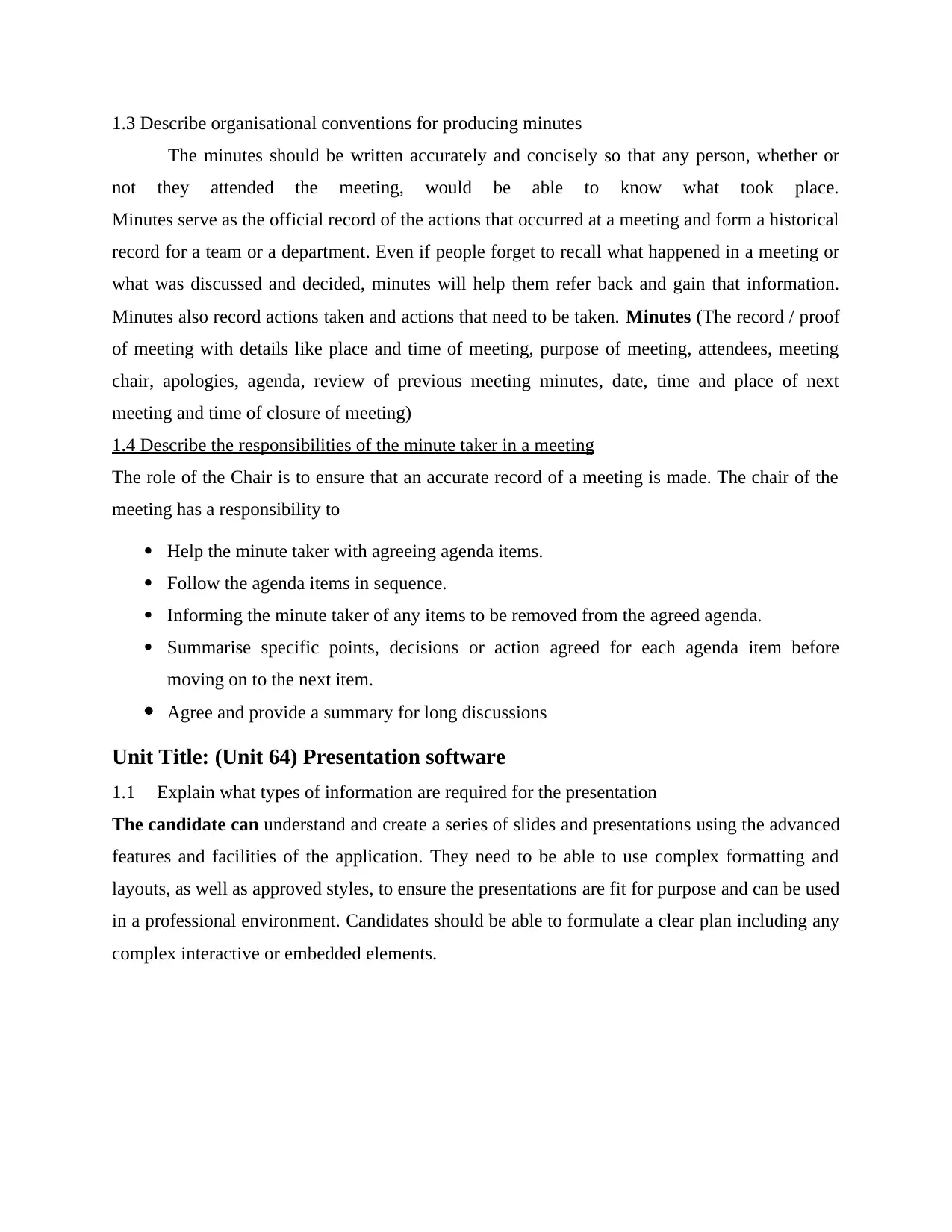
1.3 Describe organisational conventions for producing minutes
The minutes should be written accurately and concisely so that any person, whether or
not they attended the meeting, would be able to know what took place.
Minutes serve as the official record of the actions that occurred at a meeting and form a historical
record for a team or a department. Even if people forget to recall what happened in a meeting or
what was discussed and decided, minutes will help them refer back and gain that information.
Minutes also record actions taken and actions that need to be taken. Minutes (The record / proof
of meeting with details like place and time of meeting, purpose of meeting, attendees, meeting
chair, apologies, agenda, review of previous meeting minutes, date, time and place of next
meeting and time of closure of meeting)
1.4 Describe the responsibilities of the minute taker in a meeting
The role of the Chair is to ensure that an accurate record of a meeting is made. The chair of the
meeting has a responsibility to
Help the minute taker with agreeing agenda items.
Follow the agenda items in sequence.
Informing the minute taker of any items to be removed from the agreed agenda.
Summarise specific points, decisions or action agreed for each agenda item before
moving on to the next item.
Agree and provide a summary for long discussions
Unit Title: (Unit 64) Presentation software
1.1 Explain what types of information are required for the presentation
The candidate can understand and create a series of slides and presentations using the advanced
features and facilities of the application. They need to be able to use complex formatting and
layouts, as well as approved styles, to ensure the presentations are fit for purpose and can be used
in a professional environment. Candidates should be able to formulate a clear plan including any
complex interactive or embedded elements.
The minutes should be written accurately and concisely so that any person, whether or
not they attended the meeting, would be able to know what took place.
Minutes serve as the official record of the actions that occurred at a meeting and form a historical
record for a team or a department. Even if people forget to recall what happened in a meeting or
what was discussed and decided, minutes will help them refer back and gain that information.
Minutes also record actions taken and actions that need to be taken. Minutes (The record / proof
of meeting with details like place and time of meeting, purpose of meeting, attendees, meeting
chair, apologies, agenda, review of previous meeting minutes, date, time and place of next
meeting and time of closure of meeting)
1.4 Describe the responsibilities of the minute taker in a meeting
The role of the Chair is to ensure that an accurate record of a meeting is made. The chair of the
meeting has a responsibility to
Help the minute taker with agreeing agenda items.
Follow the agenda items in sequence.
Informing the minute taker of any items to be removed from the agreed agenda.
Summarise specific points, decisions or action agreed for each agenda item before
moving on to the next item.
Agree and provide a summary for long discussions
Unit Title: (Unit 64) Presentation software
1.1 Explain what types of information are required for the presentation
The candidate can understand and create a series of slides and presentations using the advanced
features and facilities of the application. They need to be able to use complex formatting and
layouts, as well as approved styles, to ensure the presentations are fit for purpose and can be used
in a professional environment. Candidates should be able to formulate a clear plan including any
complex interactive or embedded elements.
⊘ This is a preview!⊘
Do you want full access?
Subscribe today to unlock all pages.

Trusted by 1+ million students worldwide
1 out of 19
Related Documents
Your All-in-One AI-Powered Toolkit for Academic Success.
+13062052269
info@desklib.com
Available 24*7 on WhatsApp / Email
![[object Object]](/_next/static/media/star-bottom.7253800d.svg)
Unlock your academic potential
Copyright © 2020–2025 A2Z Services. All Rights Reserved. Developed and managed by ZUCOL.





